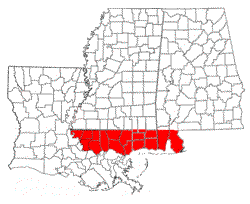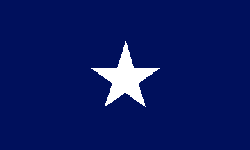
The Republic of West Florida
The Republic of West Florida is shown here as it was positioned over portions of the modern states of Louisiana, Mississippi, and Alabama. Historically it was included in the Louisiana Colony of France in 1682.
When Louisiana was ceded to Spain in 1762, West Florida went to Great Britain. There was a world war in the late 1700′s. During that war, Spain took West Florida from Great Britain in 1769. The British also lost many other North American Colonies during that world war. In 1800, Louisiana was returned to France. Spain claimed that the sale did not include West Florida. In 1803, France sold the Louisiana Territory to the U.S. West Florida had many British settlers, but was ruled by Spain. They rebelled in 1810 and established a republic.
On Saturday, September 11, 1810, a troop of dragoons under the command of Major Isaac Johnson set out for the provincial capitol at Baton Rouge. At the head of the column rode a color sergeant carrying a blue flag with a single, five-pointed white star – the Bonnie Blue Flag. This flag had been made a few days before by Major Johnson’s wife, Melissa.
Together with other republican forces under the command of Colonel Philemon Thomas, these men captured Baton Rouge without loss to themselves, imprisoned Governor de Lassus, and on September 23, 1810, raised their Bonnie Blue Flag over the fort of Baton Rouge. Three days later, John Rhea, president of the West Florida convention, signed a Declaration of Independence, and the lone star flag became the emblem of a new republic. The capital of the Republic of West Florida was St. Francisville.
The Constitution of West Florida was based largely on the US Constitution, and divided the government into three branches: executive, judicial and legislative. The legislature consisted of a Senate and House of Representatives. The Governor was chosen by the legislature. According to the constitution, the official name of the nation was the “State of Florida”. The first and only governor was Fulwar Skipwith, a former American diplomat who had helped negotiate the Louisiana Purchase.
The Republic of West Florida was short-lived. It applied to the United States for statehood, but the government of the United States, seeing Spanish rule removed from the country with neither the use of American troops nor risk to itself, decided to assert its own claim to West Florida. On October 27, 1810, President James Madison issued a proclamation declaring West Florida under the jurisdiction of the governor of the Louisiana Territory. Possession was taken of St. Francisville on December 6, 1810, and on December 10, 1810, the flag of the United States replaced the Bonnie Blue flag over Baton Rouge. The Republic of West Florida passed into history.
The tradition of a free republic lived on in the area, however. When the states that enclosed the former Republic of West Florida withdrew from the United States to help form the Confederacy, and since the C.S.A. had no official flag for the first 24 days of its existence, they used variations of the Bonnie Blue Flag to replace the U.S. Flag. The Bonnie Blue was the first flag widely used in the Confederacy and was displayed throughout the war.
Here are my sources for this article:
- The FOTW (Flags of the World) website has some good background information – centered around the flag, as you might suspect.
- The Footnotes to History website has a couple of paragraphs about the brief Republic and its background.
- The map I used came from Answers.com.
- And, of course, Wikipedia. This was my primary source, and there’s a lot more information at this link that I didn’t present. Well worth a read…


Pingback: This day in History, February 22
Pingback: This day in History, March 30